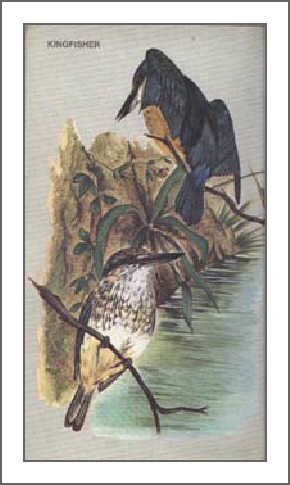


ON THIS PAGE YOU WILL FIND MORE BIRDS OF
PASTURE LAND - SCROLL DOWN TO FIND:
 (from
K is for KIWI,Reed)
(from
K is for KIWI,Reed)
Down by a pond, where a ponga tree grows, is a magical place that only I know.
It's a place full of Ps, for they grow everywhere, and all the birds who live there
have one thing they share. There's Pipit and Pheasant, Pukeko and Plover, with Pigeon to join them,
there aren't any others. Just birds whose names begin with P, these are the only birds you will see,
in this magical place known only to me.
![]()
SACRED KINGFISHER - BLACK-BACKED MAGPIE - WHITE-BACKED MAGPIE
ROOK - CANADA GOOSE - PARADISE DUCK - CAPE BARREN GOOSE -
![]()
SACRED KINGFISHER
|
|
|
Kingfisher / Kotare Halcyon sancta FAMILY: Alcedinidae
The Kingfisher is native to NZ, self introduced from Australia. Fully protected.
Common throughout NZ in a wide range of habitat, including seashore, open country,bush edges
and entering bush along water courses. They can often be seen sitting on power and
telephone lines keeping an eye out for prey onto which they will swoop. They feed mainly on mice,
lizards, insects, crabs, worms and sometimes they will dive for small fish and take small birds.
They have very short legs and prominent large bill, with a direct flight. Immature have a mottled breast.
Breeding is from October to January and they nest in holes in tree and clay banks dug by birds.
There is no nesting material and the eggs, 4-5, are shining pure white.
![]()
BLACK-BACKED MAGPIE
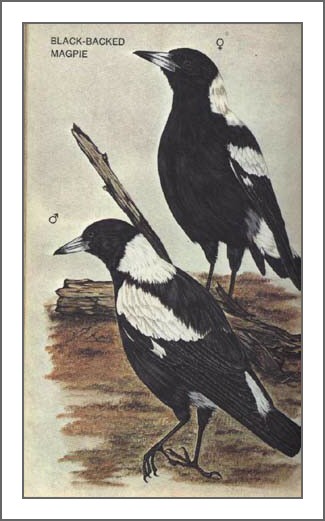
Black-backed Magpie Gymnorphina tibicen tibicen FAMILY: Cracticidae
Introduced, details unknown. Not protected. Conspicuous black and white bird with black back which distinguishes
it from the White-backed Magpie. Flute-like call. Restricted mainly to the Hawke's Bay
and Turakina districts of the North Island, and Cheviot and Kaikoura in the South Island.
Hybradises with the White-backed Magpie and produces mixed progeny with varying amounts of black
on the back. These birds may be seen over a wider area. Food consists of insects,
worms, and sometimes the eggs and young of ground-nesting birds.
Breeding is the same as the White-backed Magpie.
![]()
WHITE-BACKED MAGPIE
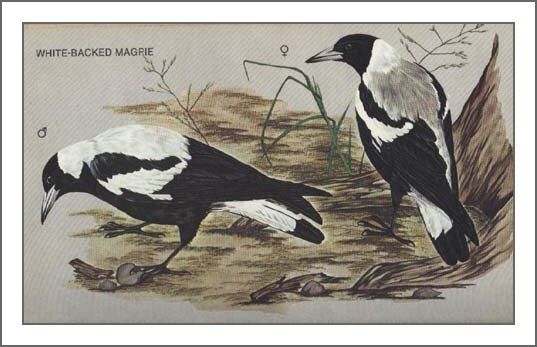
White-backed Magpie Gymnorphina tibicen hypoleuca FAMILY: Cracticidae
Introduced from Australia in the 1860s. Not protected. Found throughout NZ except in thick
bush and alpine areas. They are usually found on the outskirts of built-up areas
such as parks and golf courses etc. They generally feed on insects, worms, and sometimes the eggs
and young of ground-nesting birds. They breed from August to November and sometimes have 2 broods.
The nest is usually high in tall trees, an untidy collection of twigs, wire and other sundries,
lined with fibres and roots. The eggs, 2-5, are bluish-green, heavily blotched all over
with greyish-brown. They will boldly defend their nesting territory by dive-bombing intruders,
including human beings who come too close to the nesting area.
![]()
ROOK
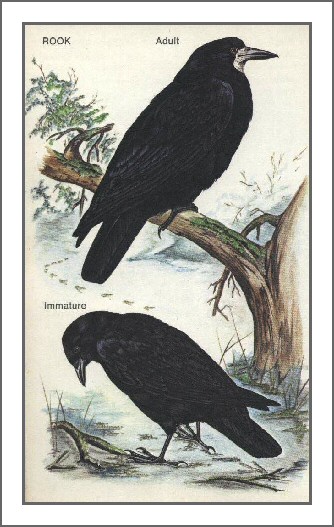
Rook Corvus frugiegus FAMILY: Corvidae
Introduced from Europe in the 1860s. Not protected. Rooks are larger than Magpies and black with
a bluish gloss all over. Only the adults have the bare skin around the base of the bill.
Large flocks of Rooks will form regular night roosts outside the breeding season.
Found in open country and plantations mainly in Hawke's Bay, South Wairarapa and Canterbury,
the largest concentration being in Hawke's Bay. They can occasionally be seen elsewhere.
Rooks feed on insects, larvae, worms, seeds and vegetable matter.
Breeding occurs from September to October. The nest is a large untidy accumulation of twigs
and mud lined with grass in the tops of large trees. The same nest is used year after year.
Nests are usually close together, forming 'rookeries', which may be very large.
The eggs, 2-4, are pale bluish-green closely covered with greyish-brown spots and blotches.
![]()
CANADA GOOSE
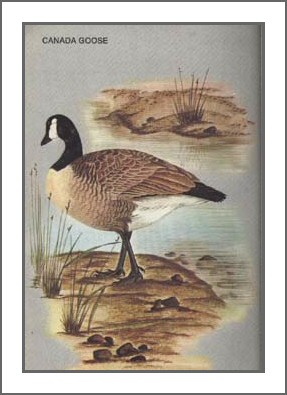
Canada Goose Branta canadensis FAMILY: Anatidae
Introduced from North America from 1876-1905. Not protected, except in certain areas.
Slighly smaller than the Black Swan, with a shorter neck. When in flight it has outstretched
neck and fast wingbeat. Found in the South Island east of the main divide,
rare in the North Island, in high country and large lakes where they may concentrate
in large flocks of moulting birds during the late Summer. They feed on grass and fodder crops.
Breeding is from October to December. The nest of grasses and tussock is made on the ground
and the eggs, 4-7, are creamy-white. The female only incubates the eggs,
with the male usually on guard nearby.
![]()
CAPE BARREN GOOSE
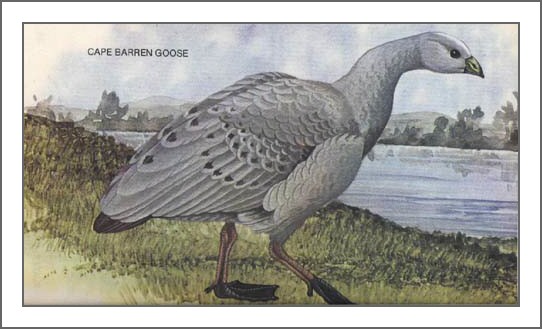
Cape Barren Goose Cereopsis novaehollandiae FAMILY: Anatidae
Introduced from Australia in 1869, 1871 and 1912 to the Otago district. Some birds may also
straggle here naturally. Not protected. A large goose, about the same size as a Canada Goose.
Extremely rare in the wild, but may be seen in captive stock in zoos. They feed on grasses along the edges
of lakes and seashores. They breed in Australia from May to December. The nest is of grasses and local
vegetation, on the ground, in the open or sometimes in dense vegetation. The eggs, 4-5, are white.














